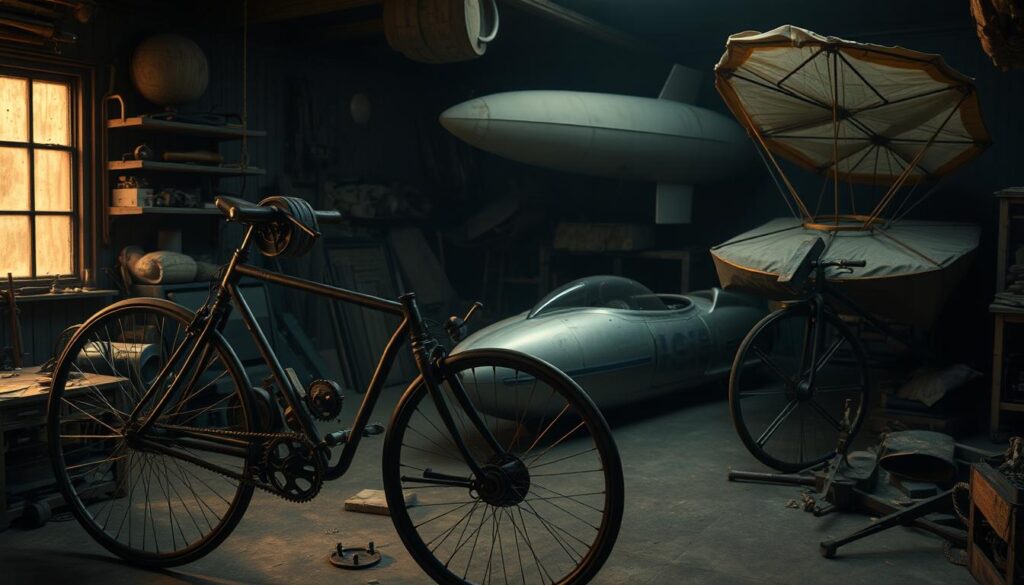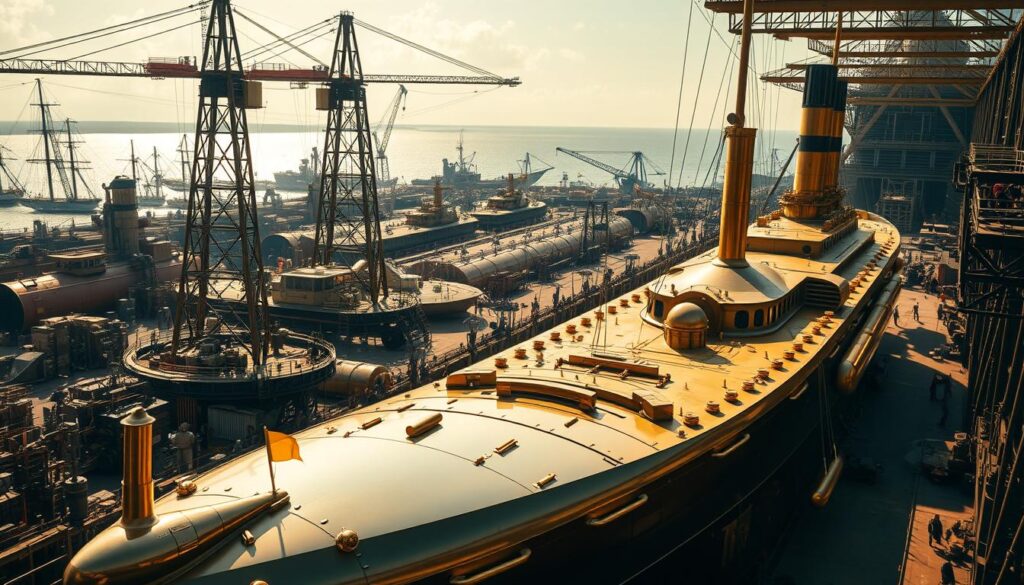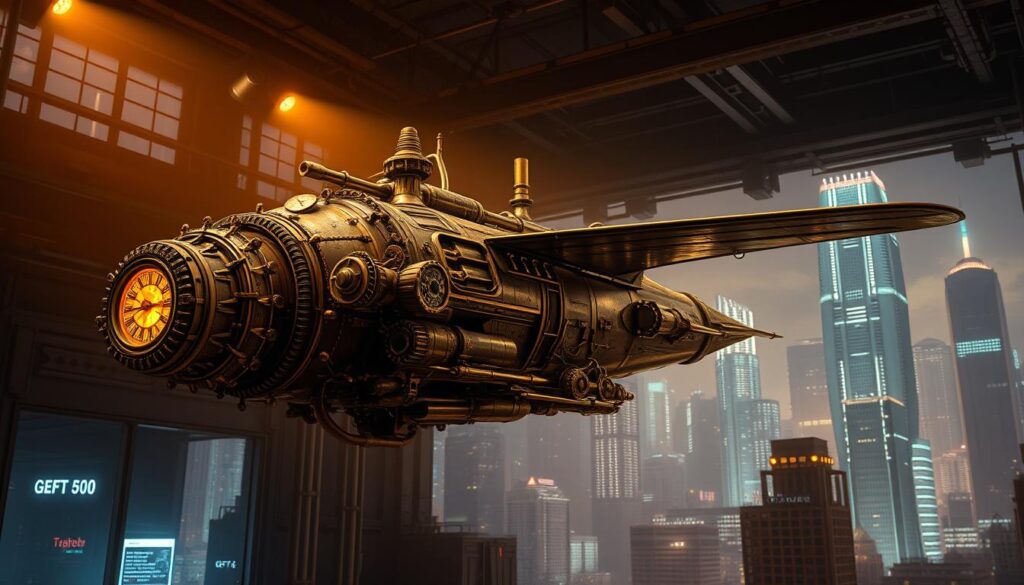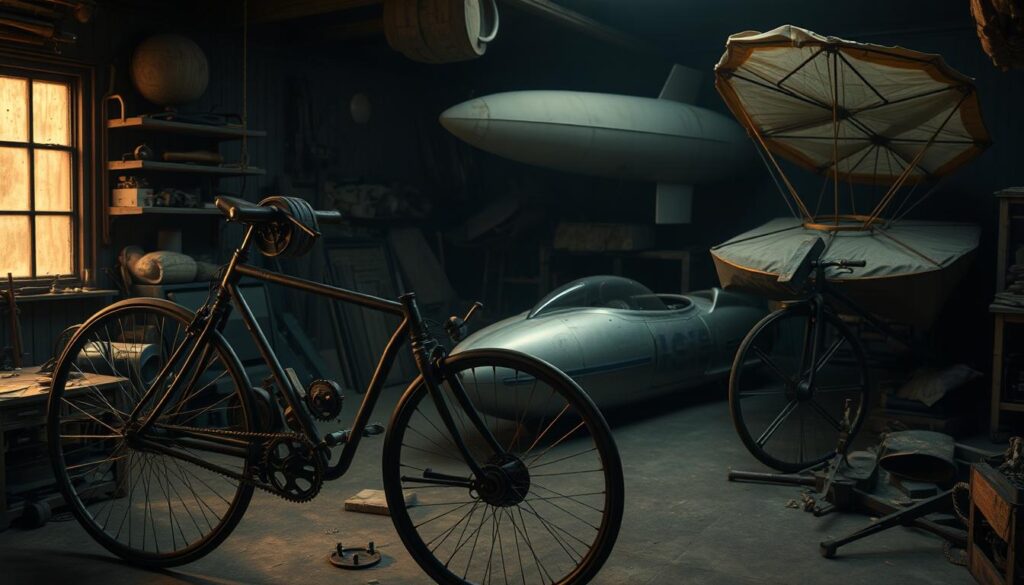Forgotten Breakthroughs in Transportation have greatly shaped our modern world. The history of getting from one place to another is filled with innovative ideas. These ideas, though often overlooked, have helped create the transportation we use today.
Looking into these forgotten inventions shows us the power of human creativity and determination. From the first attempts to the groundbreaking designs, the history of transportation is rich. It’s filled with forgotten breakthroughs that led to our modern ways of moving around.

The influence of these forgotten inventions on today’s transportation is huge. By looking at their history, we learn how they shaped our current transportation. This knowledge can also inspire new ideas in transportation.
Key Takeaways Forgotten Breakthroughs in Transportation
- Forgotten transportation inventions have significantly contributed to the development of modern transportation technologies
- Understanding the history of transportation is essential to appreciating the complexity of transportation history
- Forgotten breakthroughs in transportation have paved the way for modern transportation innovations
- Exploring lost innovations provides valuable insights into the evolution of transportation history
- Forgotten transportation inventions continue to influence the development of contemporary transportation technologies
The Hidden Evolution of Transportation Technology
Transportation technology has changed a lot over the years. Many lost innovations have helped it grow. Early steps like steam engines and canals laid the groundwork for today’s transport.
These historical inventions might seem old now. But they were key in building the transport industry we know, Forgotten Breakthroughs in Transportation.
Several things have shaped transportation tech:
- Advances in engineering and materials science
- Changes in what people want and how they behave
- Government rules and laws
There have been many failed innovations in transport tech too. These failures teach us valuable lessons. They help us make new tech better.
Looking at transport tech’s history helps us see the value of lost innovations and historical inventions. It also shows us where we can innovate more. This leads to better, greener, and more efficient ways to move around.
Steam-Powered Dreams: The Lost Prototypes
Historical accounts show a time of great innovation in transportation. Early steam power experiments are key to today’s sustainable transport goals. They teach us about the journey to better, greener ways to move.
Steam-powered cars and locomotives are examples of these early efforts. Though not widely used, they showed steam power’s potential. They faced many hurdles but helped advance transportation tech and green options.
These prototypes aimed to lessen environmental harm, a big goal today. Looking back at steam power history helps us design better, eco-friendly transport. This knowledge aids in growing sustainable transport.
Revisiting these prototypes offers many benefits:
- Improved efficiency in transportation technology
- Enhanced sustainability in transport solutions
- Reduced environmental impact
These advantages guide us in making today’s transport better and greener. They help shape the future of how we move.
The Golden Age of Forgotten Transportation Inventions
In the Victorian era, inventors were excited about historical inventions that could change how we travel. This time had many new ideas, but some never came to life. Reasons for this include lack of money, bad materials, and poor infrastructure.
Some futuristic vehicles were meant to change how we move around. Ideas ranged from steam cars to flying machines. Even though these ideas didn’t become real, they helped create today’s transportation.
Victorian Era Transportation Experiments
During this time, people worked on early bikes, trains, and even subs. These historical inventions might seem old now, but they started a new chapter in travel. The ideas from back then helped create the futuristic vehicles we have today.
Revolutionary Designs That Never Made It
Some big ideas that didn’t make it include the steam monorail and the atmospheric railway. These ideas show the creativity of inventors back then. By looking at these historical inventions, we learn more about how travel has changed and what’s possible for the future.
Flying Machines Before Wright Brothers
Forgotten Breakthroughs in Transportation – The quest for flight has led to many innovations, including alternative fuel vehicles. Many inventors and engineers have worked on aviation. They introduced lost innovations that helped create today’s air travel.
Early flying machine prototypes were made by Sir George Cayley, Otto Lilienthal, and Octave Chanute. They faced big challenges like lift, thrust, and control. But their work helped the Wright Brothers achieve their first flight, Forgotten Breakthroughs in Transportation.
Working on flying machines also helped other fields grow, like materials science and engineering. Using lightweight materials made alternative fuel vehicles more efficient and green.
Here are some key milestones in flying machine development:
- Sir George Cayley designs the first successful glider (1853)
- Otto Lilienthal builds and tests several gliders (1891-1896)
- Octave Chanute publishes a comprehensive book on aviation (1894)
- The Wright Brothers achieve the first powered flight (1903)
The history of flying machines shows human creativity and innovation. By looking at lost innovations and learning from history, we can keep improving. This will help us create a greener future for travel, including alternative fuel vehicles.
Revolutionary Rail Systems That Disappeared
Looking into the transportation history of rail systems, we find many innovative ideas. These ideas, though promising, never became widely accepted. One key area was the push for sustainable transport to lessen the environmental impact of rail travel.
Records show that experimental rail systems, like atmospheric railways and monorails, were made to be efficient and green. Though they were left behind, they teach us valuable lessons for today’s rail travel.
Lessons from the Past
By studying these old rail systems, we learn how to make modern rail travel better. This knowledge helps us create new, green rail systems. These systems aim to cut down on fossil fuel use and environmental harm.
Forgotten Innovations
Some of the forgotten innovations in rail transport include:
- Atmospheric railways that used vacuum-sealed tubes to propel trains
- Abandoned monorail concepts that could have reduced land use and environmental impact
- Forgotten track designs that prioritized sustainability and efficiency
These innovations, though not adopted widely, show the power of transportation history in shaping sustainable transport solutions.
Maritime Innovations Lost to Time
Historical inventions have greatly shaped our transportation technology. In the maritime world, many innovations have been forgotten. These include early ship designs, propulsion systems, and navigation technologies. They could help improve how we travel by sea today.
For example, steam-powered ships and iron hulls made sea travel more efficient and sustainable. But, they were eventually replaced by newer tech. By looking back, we can learn how to make today’s transportation better.
Historical inventions can guide us in several key areas. These include:
- Efficient propulsion systems
- Sustainable ship designs
- Advanced navigation technologies
By exploring these areas, we can make new transportation tech more efficient and green. Historical inventions offer insights into achieving these goals. They help us build a better future for sea travel.

As we create new transportation tech, we must remember the past. Learning from history, we can make sea travel more sustainable and efficient. This way, yesterday’s inventions will shape tomorrow’s tech.
Urban Transportation Concepts That Never Caught On
Cities are growing fast, and we need better ways to get around. In the past, many new ideas for moving people were suggested. But, they didn’t work out. These ideas included new ways to travel and design streets, Forgotten Breakthroughs in Transportation.
Some ideas, like monorails and podcars, aimed to cut down on traffic. Others, like electric buses and hybrid taxis, wanted to help the environment. Yet, these plans didn’t catch on.
Here are a few examples:
- Personal rapid transit systems, which used small vehicles to transport individuals quickly and efficiently
- Automated guideway transit systems, which used computer-controlled vehicles to transport people along a fixed route
- Innovative street designs, such as pedestrian-only zones and bike-friendly roads, which aimed to reduce congestion and promote sustainable transportation – Forgotten Breakthroughs in Transportation.
Looking at these failed ideas can teach us a lot. We can learn how to make better transportation systems. These systems should use futuristic vehicles and alternative fuel vehicles, Forgotten Breakthroughs in Transportation.
The Rise and Fall of Alternative Fuel Vehicles
The world is moving towards sustainable transport. It’s important to look back at the history of alternative fuel vehicles. From the first tries to today’s advancements, the journey of alternative fuels has seen ups and downs. Electric and hybrid cars, for example, have been key in making transport greener.
Several things have helped alternative fuel vehicles grow and decline. These include:
- Societal changes, like what people want and government rules
- Economic shifts, like fuel price changes and making costs
- Technological leaps, like better batteries and fuel use
Looking at the past of alternative fuel vehicles teaches us a lot. It shows how sustainable transport has evolved. Pioneers’ work guides today’s green transport efforts. As we go on, learning from the past is key to a greener future, Forgotten Breakthroughs in Transportation.
Rediscovered Patents That Could Transform Modern Transit
Exploring lost innovations reveals secrets for bettering modern transport. Historical patents and research hold environmental solutions and efficiency innovations waiting to be rediscovered. These can improve transportation technology without losing clarity or context, Forgotten Breakthroughs in Transportation.
Some key areas where lost innovations can make a big difference include:
- Alternative fuel sources like hydrogen or electric power, cutting down on fossil fuel use and carbon emissions
- Advanced public transit systems, such as hyperloop or magnetic levitation trains, speeding up travel and boosting efficiency
- Smart traffic management systems that can better manage traffic flow and cut down on congestion
By diving into these transportation technology innovations, we can build a greener and more efficient transport system. As we tackle challenges in transport sustainability and efficiency, looking back for inspiration is crucial.

The secret to changing modern transit is learning from the past and updating lost innovations for today’s needs. This way, we can build a brighter future for all, Forgotten Breakthroughs in Transportation.
Modern Applications of Historical Transportation Technologies
Historical inventions have led to today’s transportation solutions. Many futuristic vehicles are inspired by old ideas. For example, magnetic levitation trains were first thought of in the 20th century. Now, they’re being used around the world, Forgotten Breakthroughs in Transportation.
Here are some examples of how old ideas are used today:
- Electric cars, first seen in the 19th century
- High-speed trains, an idea from the early 20th century
- Advanced public transit systems, built from historical research
These examples show how old ideas can solve today’s transportation problems. By updating and using old technologies, we can make vehicles more efficient and futuristic.
As we keep exploring and using old transportation ideas, we’ll see new solutions. By learning from history and improving historical inventions, we can make transportation better for the future.
Why These Innovations Matter Today
Knowing transportation history is key to making sustainable transport better. By looking at past successes and failures, we learn valuable lessons. These lessons help us build more efficient and green transport systems.
Forgotten Breakthroughs in Transportation – Understanding the past helps us make smarter choices today. By studying how transport technologies evolved, we see what shaped them. Forgotten Breakthroughs in Transportation, This knowledge helps us tackle today’s big challenges, like cutting carbon emissions and upgrading our roads.
- It makes our systems more efficient by learning from past designs.
- It inspires ways to make transport greener, following in the footsteps of past successes.
- It sparks new ideas by looking at what worked and what didn’t before.
By using the wisdom of transportation history to tackle today’s problems, we can build a greener future. This future will be better for everyone and for our planet.
Some forgotten transportation inventions may have paved the way for old tech that was ahead of its time
Conclusion: The Future of Transportation Through the Lens of the Past
Forgotten Breakthroughs in Transportation – The history of transportation is rich with forgotten inventions and lost breakthroughs. Some of these never became mainstream, but they still offer valuable lessons. By looking back, we can learn to make transportation better, more sustainable, and efficient, Forgotten Breakthroughs in Transportation.
Looking at the past, we see the potential of alternative fuel vehicles and advanced rail systems. These ideas were ahead of their time. As we face today’s transportation challenges, revisiting these innovations can spark new ideas. This way, we can move forward faster and create a better future, Forgotten Breakthroughs in Transportation.
FAQ
What are some of the forgotten transportation inventions that have shaped history?
History is full of forgotten transportation inventions. These include early steam-powered vehicles, innovative rail systems, and cars that run on alternative fuels. They all played a big role in how we travel today, Forgotten Breakthroughs in Transportation.
Why are some transportation breakthroughs forgotten or neglected?
There are many reasons why some inventions are forgotten. They might not have been widely used or didn’t make it in the market. Sometimes, they were overshadowed by more successful ideas. Historical attitudes and technology limits also played a part, Forgotten Breakthroughs in Transportation.
What can we learn from rediscovering these forgotten transportation technologies?
Looking into the past can teach us a lot about today’s transportation problems. These old ideas might help us make travel greener, faster, and more efficient. By learning from history, we can improve our future transport systems, Forgotten Breakthroughs in Transportation.
How have early flying machine prototypes influenced the development of modern aviation?
Before the Wright Brothers, many were trying to make flying machines work. Their early designs, though not all successful, helped pave the way for today’s airplanes. They pushed the boundaries of what was thought possible in flight.
What happened to revolutionary rail systems that were never widely adopted?
History shows many rail systems that didn’t catch on, like atmospheric railways and monorails. They faced tech hurdles and funding issues. Yet, knowing why they failed can guide us in making today’s rail systems better.
How have maritime innovations been forgotten or overlooked?
Forgotten Breakthroughs in Transportation – The sea has seen many forgotten innovations, from ship designs to navigation tools. These old ideas can help us make shipping safer, greener, and more efficient. Rediscovering them could lead to new maritime solutions.
What can we learn from urban transportation concepts that never caught on?
History is full of urban transport ideas that didn’t make it, like personal transit systems and street designs. Looking at these can teach us about today’s urban transport needs. They offer lessons on futuristic vehicles and sustainable infrastructure, Forgotten Breakthroughs in Transportation.
How have historical alternative fuel vehicle innovations influenced modern transportation?
The history of alternative fuel vehicles is complex, with many forgotten attempts. From steam cars to electric vehicles, understanding these past efforts can guide us in making transport more eco-friendly. It helps us find ways to use less fossil fuel, Forgotten Breakthroughs in Transportation.
What historical transportation patents and innovations could transform modern transit?
History holds many transportation patents and innovations that could change our transit today. These include green solutions and ways to make travel more efficient. By revisiting these ideas, we can make a big impact on how we travel, Forgotten Breakthroughs in Transportation.
Source link
- https://www.nationalgeographic.com/history/article/history-of-new-yorks-19th-century-electric-cabs
- https://www.wired.com/story/british-hyperloop-hovertrain-maglev-trains
- https://www.morningagclips.com/history-of-snow-rollers-forgotten-heroes-of-winter-travel/
- https://www.history.com/articles/transcontinental-railroad-changed-america
